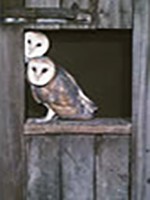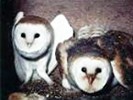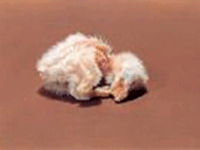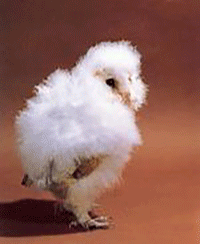Breeding Cycle
|
Barn Owls are usually monogamous, only selecting a new partner if the original has died. The pair stay in contact with each other throughout the year. They may roost apart sometimes, especially when the female is incubating eggs.
In a normal year, courtship begins in February or March and typically involves bill fencing with the male bringing food for the female. If the winter has been mild and prey is plentiful, the female may reach breeding condition much earlier.
|
 www.georgemccarthy.com |
 |
|
2-9 white eggs are normally laid; average is 5. They have a matt surface texture and are often slightly pointed at one end; other owl eggs are generally more round. Incubation period for each egg: 30 – 31 days. Hatching asynchronous (staggered) at 48-60 hour intervals. |
 |
 |
On hatching (right), the young are altricial (blind, naked and helpless) and utterly dependent on the adult female for warmth. The male brings prey into the nest and the female tears it into strips for the owlets.
By 3 weeks old, the owlets are developing a warm white down. Owlets begin to make a hissing or ’snoring’ sound around third week, especially when an adult arrives with food.
Most feeding of the young is in July and August, when mice and voles are most abundant.
|
|
Both parents now bring food to the nest, although the male brings most.
By 5 – 6 weeks old, the owlet can walk and may well climb around the nest area.
During the 8th week, 1st attempts at short flight hops are made.
By the 9th week, the white down is disappearing and the owlets may be indistinguishable from parents except for excitable behaviour and exaggerated head movements. Oldest owlets leave the nest to fly around immediate area.
|
 |
|
By the 10th week, the female trains young to catch prey: she brings prey near to the nest, then entices young out and drops prey into the grass, where the young dive in after it.
Around the 11th week, young owls are able to catch their first prey for themselves.
In an average year, young Barn Owls stay around the natal area until the end of October and then begin to disperse. If, however, breeding has taken place very early in the year, the young may disperse during the summer and may even find a partner before the end of the year.
|